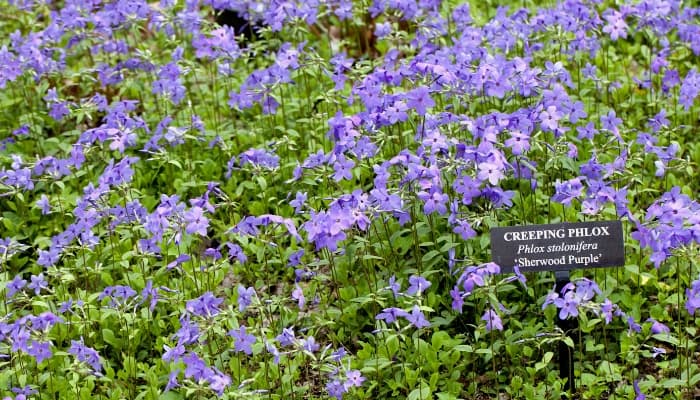Creeping phlox can add beautiful bursts of lush greenery and vibrant flowers to your garden, but it has the potential to take over completely.
With its spreading habit, it can be great to use for slopes, as an underplanting in your garden, or to cover an unsightly area with ease.
Are creeping phlox invasive? Since creeping phlox (Phlox stolonifera) uses runners to spread and also produces abundant seeds, it is considered an invasive species. It will only take a few seasons for seedlings to cover a large area. It will also grow dense enough to outcompete other smaller species.
While creeping phlox can be invasive, it is a lovely ground cover that is used by gardeners and admired for its lush growth and abundant flowers.
Read on to understand its growth habit, why it can be invasive, and how to control it.
Creeping Phlox Growth
If given full sun, appropriate water, and preferable soil, creeping phlox will overtake an area before you know it. While it doesn’t grow tall, it will spread outward exponentially season after season.
Creeping Phlox Growth Rate
With a moderate growth rate, creeping phlox can become invasive if left unmanaged.
If you plant an area with seedlings about 18 inches apart, it should take approximately 2 years to completely fill the space. Once it reaches a height of 6-8 inches, it will stop growing in height.
Creeping Phlox Size
Creeping phlox has a growth habit that makes it want to grow outward rather than up. With a short growing height, it will grow as far and wide as it can!
While it doesn’t grow more than a few inches tall, it will grow up rocks and over anything it has to ability to root onto.
Creeping Phlox Height
Lying low and “creeping” across the ground, this variety of phlox grows to a short height of 3 to 8 inches tall.
Creeping Phlox Spread
Over time, creeping phlox will cover any soil area it can grow into. Planting an area with seedlings about 12 to 18 inches apart will result in the entire area being covered after only a few seasons.
Each plant will spread about 2 feet, but it will also continue to spread out beyond that area if the space allows!
Creeping Phlox Growth Habit
Creeping phlox is a low-growing variety that will expand to cover almost any area as long as it has the ability to root. It doesn’t grow tall, but it does grow wide.
How Does Creeping Phlox Spread?
Producing runners that root along the ground, creeping phlox will spread anywhere open soil space is available.
It will also produce seeds that will drop and germinate, starting new plants to help create a dense layer of the plant.
Invasiveness
Since it will spread out creating runners and rooting anywhere it can, it can be invasive to your garden.
It will also produce a carpet of flowers in the spring and early summer, which produce seeds in late summer.
A bountiful amount of flowers equals a bountiful amount of seeds that will start new plants everywhere!
Creeping Phlox Bloom Time
An early-season bloomer, creeping phlox will flower in the spring and early summer with white, pink, light blue, or purple flowers.
Creeping Phlox Spacing
When planting new seedlings, it is best to space them out anywhere from 1 to 2 feet apart.
Each plant will easily cover an area of 2 feet on its own, eventually filling in the space between plants only after a few seasons.

How To Control Creeping Phlox
Since it can be invasive and take over your garden, you should always try to keep up maintenance so it remains where you want it to be and nowhere else.
See the tips below to keep your patch of creeping phlox manageable and prevent it from out-competing many of your other plantings.
1. Prune Regularly
Regularly pruning your phlox will redirect energy into growing new shoots rather than spreading out more.
It is alright to prune it back by ½ to ⅓ of its height each season. Prune any runners that are beginning to expand beyond the area you are growing in before they root and expand their reach.
2. Deadhead Flowers
Since phlox will flower abundantly, it will also create abundant seeds.
Removing any flowers that begin to go to seed after opening will prevent the seeds from forming, falling to the ground, and growing more phlox.
3. Plant in Containers
If you don’t want phlox to grow as a ground cover throughout your garden, place pots around, and plant them in these. This way you will still have phlox, but it won’t root and spread out through the garden.
Be careful of seeds falling to the ground because these will grow and eventually, if left unmanaged, overtake your garden.
4. Plant it Within a Border or Among Strong Rooting Plants
Using rocks, bricks, or landscaping edging around your phlox plants will keep them contained within a certain area.
They will still try to grow outside of the border, but it will help keep the plants contained easily.
How To Prune Creeping Phlox
Creeping phlox grows as a dense mat of foliage and flowers. Pruning it can seem difficult due to its spread but is easier than you think! See the steps below to prune it with ease.
- Wait until after spring when all of the flowers have bloomed. Pruning before flowers open will remove the buds and all chances of the flowers forming.
- Sometimes phlox can become leggy and tall, so it is important to locate where the ½ point is. You won’t want to prune more than ½ off, especially if it has a lower brown portion to the stem. This will remove all of the green foliage and make it difficult for the phlox to regrow.
- Use hedging sheers or a hedge trimmer to prune an even layer to a height between 3 and 5 inches tall, depending on its original height.
- Remove the pruning debris. It is alright to brush it into the remaining foliage because it will act as green-waste mulch, feeding the phlox over time and reducing the chances of weeds forming.
Related Questions:
Can You Walk on Creeping Phlox?
Creeping phlox is a hardy, resilient plant, so walking on it should pose no issue! However, if it is continually walked on in the same area, it will suppress the plant’s growth enough that it may die in the area.
How Many Colors of Creeping Phlox Are There?
There are four main colors that you’ll find in creeping phlox: white, purple, pink, and blue.
They usually have a light tone to all of these colors and sometimes will flower in color combinations like pink and white or purple and white.
Conclusion
Creeping phlox may be invasive and take over your yard but only if you let it!
There are easy ways to prevent it from doing so. Just stay on top of it because once it has rooted, it is difficult to fully remove it from the soil.

